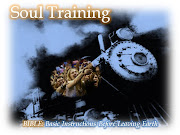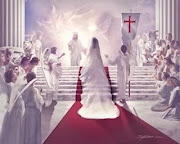 This celebration was planned before time began. Heightened senses will experience the unimaginable, with the sights, sounds, aroma and atmosphere of a feast. And this life’s faith and hope will finally be satisfied by an unconditional love that is extended without measure. At this time, the Lord and his bride (the elect) will then know and be known in the perfect manner intentioned from the beginning.
This celebration was planned before time began. Heightened senses will experience the unimaginable, with the sights, sounds, aroma and atmosphere of a feast. And this life’s faith and hope will finally be satisfied by an unconditional love that is extended without measure. At this time, the Lord and his bride (the elect) will then know and be known in the perfect manner intentioned from the beginning.Pictured figuratively in the Feast of Trumpets, the wedding supper of the Lamb will soon commence as we near the consummation of history. And with the start of the Jewish New Year, biblical scholars now suggest we're within a one year window. As such, this month A.D. 2018 takes a look at how both the historic Wedding Model and Feasts of the Lord symbolize literal events for the elect. While words alone are sure to fail us in describing what happens when the hearts of men engage with the King of Kings, let’s just say it will be something beautiful.
The Wedding Model
by Chuck Missler
All through the Gospels, Jesus relied on the ancient Jewish wedding pattern for many of His parables, climaxing in His promise in the Upper Room in John 14. Many of us miss the full import of these allusions if we aren't familiar with the model of ancient Jewish wedding practices.
The Jewish Wedding
The first step, the Ketubah, or Betrothal, was the establishment of the marriage covenant, usually when the prospective bridegroom took the initiative and negotiated the price (mohair) he must pay to purchase her.
Once the bridegroom paid the purchase price, the marriage covenant was established, and the young man and woman were regarded as husband and wife. From that moment on, the bride was declared to be consecrated or sanctified - set apart - exclusively for her bridegroom. As a symbol of the covenant relationship that had been established, the groom and bride drank from a cup of wine over which the betrothal had been pronounced.
After the marriage covenant was established, the groom left his bride at her home and returned to his father's house, where he remained separated from his bride for approximately months. This afforded the bride time to gather her trousseau and prepare for married life.
During this period of separation, the groom prepared a dwelling place in his father's house to which he would later bring his bride.
Additionally, the bridegroom who labored on the new room for the bride would show this room to his father and ask if it was ready, the father was the one to decide, so here too, no one knew when the time was, only the father.
At the end of the period of separation, the bridegroom came - usually at night - to take his bride to live with him. The groom, the best man, and other male escorts left the father's house and conducted a torch-light procession to the home of the bride (she was taken in a box, lifted carried to the groom's house).
Although the bride was expecting her groom to come for her, she did not know the time of his coming. As a result, the groom's arrival was preceded by a shout, which announced her imminent departure to be gathered with him.
After the groom received his bride, together with her female attendants, the enlarged wedding party returned from the bride's home to the groom's father's house, where the wedding guests had assembled.
Shortly after their arrival, the bride and groom were escorted by the other members of the wedding party to the bridal chamber (huppah). Prior to entering the chamber, the bride remained veiled so that no one could see her face.
While the groomsmen and bridesmaids waited outside, the bride and groom entered the bridal chamber alone. There, in the privacy of that place, they entered into physical union for the first time, there by consummating the marriage that had been covenanted approximately one year earlier.
After the marriage was consummated, the groom came out of the bridal chamber and announced the consummation of the marriage to the members of the wedding party waiting outside. Then, as the groom went back to his bride in the chamber, the members of the wedding party returned to the wedding guests and announced the consummation of the marriage.
Upon receiving the good news, the wedding guests remained in the groom's father's house for the next seven days, celebrating with a great wedding feast.
During the seven days of the wedding feast, the bride and groom remained hidden in the bridal chamber (Cf. Genesis 29:21-23, 27-28) for the seven days of the huppah. Afterwards, the groom came out of hiding, bringing his bride with him, but with her veil removed so that everyone could see her.
The Ultimate Bride
The New Testament portrays the Church as the Bride of Christ in Ephesians 5:22-33 (Paul even quotes Genesis 2:24 as the union at the Parousia of the Bridegroom in v.31); cf. Romans 7:4; 2 Corinthians 11:2; James 4:4. In the opening verses of John 14, the marriage covenant is confirmed. Paul continually reminds us of the purchase price and the covenant by which we, the Bride, are set apart, or sanctified, consistent with the Lord’s ancient wedding model.
The Feasts of Israel
Do they have prophetic significance?
by Dr. David R. Reagan
"Let no one act as your judge in regard to food or drink or in respect to a festival or a new moon or a Sabbath day things which are a mere shadow of what is to come; but the substance belongs to Christ." Colossians 2:16-17 (NASB)
This statement by the Apostle Paul refers to the Jewish Feasts as a "mere shadow" of things to come, the substance of them being found in Yeshua, the Messiah. What Paul is saying here is that the feasts were prophetic types, or symbols, that pointed to the Messiah and which would be fulfilled in Him.
Before we pursue that point to see how the feasts were fulfilled in Jesus, let's first of all familiarize ourselves with the feasts.
Origin and Timing of the Feasts
The feasts were a part of the Mosaic Law that was given to the Children of Israel by God through Moses (Exodus 12; 23:14-17; Leviticus 23; Numbers 28 & 29; and Deuteronomy 16). The Jewish nation was commanded by God to celebrate seven feasts over a seven month period of time, beginning in the spring of the year and continuing through the fall. You will find the timing and sequence of these feasts illustrated on the chart below.

As you study the chart, notice that the feasts fall into three clusters. The first three feasts Passover, Unleavened Bread, and First Fruits occur in rapid succession in the spring of the year over a period of eight days. They came to be referred to collectively as "Passover."
The fourth feast, Harvest, occurs fifty days later at the beginning of the summer. By New Testament times this feast had come to be known by its Greek name, Pentecost, a word meaning fifty.
The last three feasts Trumpets, Atonement, and Tabernacles extend over a period of twenty-one days in the fall of the year. They came to be known collectively as "Tabernacles."
The Nature of the Feasts
Some of the feasts were related primarily to the agricultural cycle. The feast of First Fruits was a time for the presentation to God of the first fruits of the barley harvest. The feast of Harvest was a celebration of the wheat harvest. And the feast of Tabernacles was in part a time of thanksgiving for the harvest of olives, dates, and figs.
Most of the feasts were related to past historical events. Passover, of course, celebrated the salvation the Jews experienced when the angel of death passed over the Jewish houses that were marked with the blood of a lamb. Unleavened Bread was a reminder of the swift departure from Egypt so swift that they had no time to put leaven into their bread.
Although the feasts of Harvest and Tabernacles were related to the agricultural cycle, they both had historical significance as well. The Jews believed that it was on the feast day of Harvest that God gave the Law to Moses on Mt. Sinai. And Tabernacles was a yearly reminder of God's protective care as the Children of Israel tabernacled in the wilderness for forty years.
The Spiritual Significance of the Feasts
All the feasts were related to the spiritual life of the people. Passover served as a reminder that there is no atonement for sin apart from the shedding of blood. Unleavened Bread was a reminder of God's call on their lives to be a people set apart to holiness. Leaven was a symbol of sin. They were to be unleavened that is, holy before the nations as a witness of God.
The feast of First Fruits was a call to consider their priorities, to make certain they were putting God first in their lives. Harvest was a reminder that God is the source of all blessings.
The solemn assembly day of Trumpets was a reminder of the need for constant, ongoing repentance. The Day of Atonement was also a solemn assembly day a day of rest and introspection. It was a reminder of God's promise to send a Messiah whose blood would cover the demands of the Law with the mercy of God.
In sharp contrast to Trumpets and Atonement, Tabernacles was a joyous celebration of God's faithfulness, even when the Children of Israel were unfaithful.
The Prophetic Significance of the Feasts
What the Jewish people did not seem to realize is that all of the feasts were also symbolic types. In other words, they were prophetic in nature, each one pointing in a unique way to some aspect of the life and work of the promised Messiah.
1) Passover — Pointed to the Messiah as our passover lamb whose blood would be shed for our sins. Jesus was crucified on the day of preparation for the Passover, at the same time that the lambs were being slaughtered for the Passover meal that evening.
2) Unleavened Bread — Pointed to the Messiah's sinless life, making Him the perfect sacrifice for our sins. Jesus' body was in the grave during the first days of this feast, like a kernel of wheat planted and waiting to burst forth as the bread of life.
3) First Fruits — Pointed to the Messiah's resurrection as the first fruits of the righteous. Jesus was resurrected on this very day, which is one of the reasons that Paul refers to him in I Corinthians 15:20 as the "first fruits from the dead."
4) Harvest or Pentecost — (Called Shavuot today.) Pointed to the great harvest of souls, both Jew and Gentile, that would come into the kingdom of God during the Church Age. The Church was actually established on this day when the Messiah poured out the Holy Spirit and 3,000 souls responded to Peter's first proclamation of the Gospel.
The long interval of three months between Harvest and Trumpets pointed to the current Church Age, a period of time that was kept as a mystery to the Hebrew prophets in Old Testament times.
That leaves us with the three fall feasts which are yet to be fulfilled in the life and work of the Messiah. Because Jesus literally fulfilled the first four feasts and did so on the actual feast days, I think it is safe to assume that the last three will also be fulfilled and that their fulfillment will occur on the actual feast days. We cannot be certain how they will be fulfilled, but my guess is that they most likely have the following prophetic implications:
5) Trumpets — (Called Rosh Hashana today.) Points to the Rapture when the Messiah will appear in the heavens as a Bridegroom coming for His bride, the Church. The Rapture is always associated in Scripture with the blowing of a loud trumpet (I Thessalonians 4:13-18 and I Corinthians 15:52)
6) Atonement — (Called Yom Kippur today.) Points to the day of the Second Coming of Jesus when He will return to earth. That will be the day of atonement for the Jewish remnant when they "look upon Him whom they have pierced," repent of their sins, and receive Him as their Messiah (Zechariah 12:10 and Romans 11:1-6, 25-36).
7) Tabernacles — (Called Sukkot today.) Points to the Lord's promise that He will once again tabernacle with His people when He returns to reign over all the world from Jerusalem (Micah 4:1-7).



















